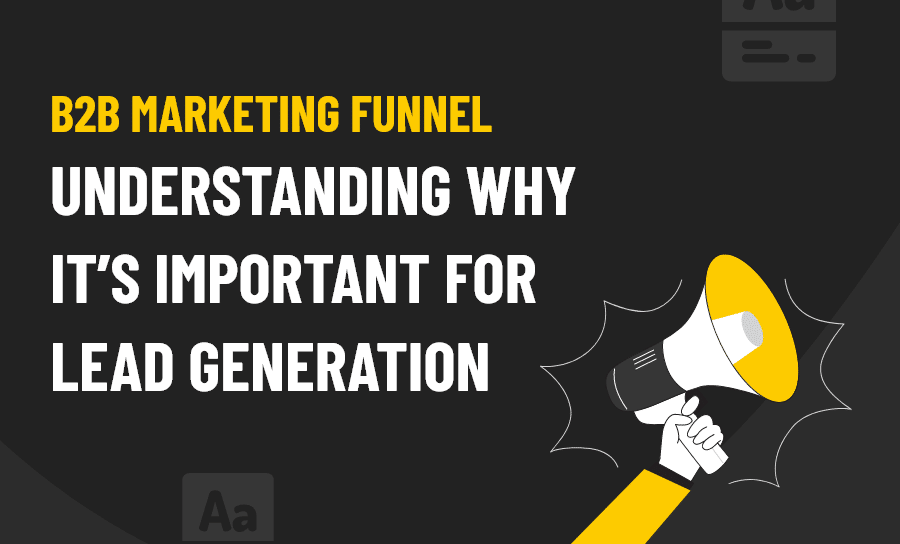B2B Marketing Funnel: Optimizing Your Strategy
The marketing funnel is a fundamental part of any marketing strategy for a business, no matter what that business might be.
After all, it’s primary job is to help you understand how to gain more consumers!
However, it’s important to get your funnel right otherwise you won’t be able to generate the leads you need, which ultimately will negatively affect your business.
So let’s take a look at how you can make an effective B2B marketing funnel.
What is the B2B marketing funnel?
First things first, we need to start with the basics – what actually is a marketing funnel?
A marketing funnel is a set of stages that map the customer journey from their first awareness of your brand all the way down to their purchase.
Marketers can then measure how effectively they are filling the funnel with new leads, how well those leads convert in each stage and what lead generation techniques are giving the best results and which ones might need some tweaking.
In this way, the marketing funnel can be used to define and improve your marketing strategy!
Also, just to make sure we’re on the same page going forward, B2B means ‘business to business’, so when talking about a B2B marketing funnel, we’re referring to a ‘business to business marketing funnel’.
Stages of the marketing funnel
A strong marketing funnel can be broken down into the following 6 stages:
1 - Awareness
In this stage, potential customers who’ve never heard of you before are just starting to hear about you and understand what your business is about.
Generating awareness can be done in a wide variety of ways; as long as you’re reaching new prospects on relevant platforms and driving traffic to your website, then you’re creating awareness!
Some ways this can be done are:
- Social media (LinkedIn, Instagram, Facebook, Twitter, etc)
- Search engines (Google, Bing, Youtube)
- Referrals (Reviews, guest posts, etc)
This is the very first stage of lead generation in the marketing funnel so it’s important that you build a strong presence on whatever platforms you choose to market on!
For B2B marketing, a great place to start is LinkedIn.
LinkedIn is home to a huge variety of different businesses and can be an excellent place to create a network of connections!
2 - Interest
You’ve attracted an audience so now it’s time to build up their interest!
The main aim is to stay connected to them and establish a communication – you want them to remember who you are so that they come back later on.
Ways you can build interest include:
- Guiding them through different pages on your website (through links in the menu bar and footer, links to other relevant blog posts if they arrived to your website through a blog post, etc)
- Retargeting them with personalised ads on social media that have relevant information in them related to the pages they were previously looking at
3 - Action
Now that some of your audience have revisited your website, you want to make them take action on your landing page.
Some examples of how action can be encouraged include:
- Buttons saying ‘Download now!’
- Buttons saying ‘Request a callback’ or ‘Request a demo’
- Landing pages that offer discounts to the audience if they provide their email address
These landing page call to actions (CTAs) are very important parts of your lead generation because once the audience engages with them you have their data and can further nurture them towards that final purchase!
4 - Engage

Congratulations!
You now have data on your most prospective audience members – people who are more likely than the rest to become your customers!
Now, you want to keep your prospective audience members engaged in your content so that they remember you, stay interested, and keep coming back.
This can be achieved through a number of ways, such as:
- Blog posts
- Customer testimonials
- Whitepapers
- Case studies
- Email newsletters
This stage is often regarded as one of the most important stages – if not the most important – in the whole marketing funnel.
Why?
Well, it’s largely because what you do in this stage and how you keep your audience engaged and interested will determine how far your conversation into sales will be able to go.
If you can’t keep them engaged, then they won’t buy, no matter how big of an audience you manage to generate!
5 - Nurturing and opportunity
Now, the sales team will want to talk to the audience members who showed a high level of engagement in the previous stage.
This is usually done by sending out highly focused emails and general cold outreach, which becomes more effective at this stage since your audience has already shown an interest and they already know your brand.
If this is successful, and the conversation moves forward, then the sales representative can set up their first meeting and the ‘opportunity’ happens.
6 - Sales/customers
An audience member becomes a lead when you manage to get data on them (usually an email).
A lead becomes a customer when they take the opportunity and commit to a business engagement with your company – this is the win you’re after!
This can take as little as a day to anywhere close to a couple of months, particularly for B2B sales since there might be many decision-makers involved and a budget that needs to be negotiated.
An important thing to remember is that you never want to leave your customers in the dark – this only leads to distrust and ultimately losing your audience.
Winning is much easier when you take the time to educate your potential customers on the problems they might have and what solutions you can offer them to help.
Why is lead generation so important?
Lead generation is incredibly important at every stage of the marketing funnel.
Fundamentally, it’s how you draw in your potential customers and keep them moving down the funnel.
If you miss an opportunity for lead generation in the top, middle or bottom of your funnel, you might lose out on a lot of leads and customers!
Top of the funnel
Generating quality traffic to your website is the first step of lead generation in the funnel – after all, you aren’t going to get any customers further down the funnel if you don’t pull them in here.
What you don’t want to end up with is really low top-of-funnel lead numbers – this will impact your business quite dramatically because it reduces the number of leads you’ll have further down the funnel!
The best way to generate quality traffic is to figure out which platforms the large majority of your target audience are using and build your presence there.
This can be social media sites, paid ads, listing websites, in the search engine – anywhere really.
The key is to simply be driving initial traffic to your website.
Middle of the funnel
Once people are looking at your website, you want to keep them there for as long as possible.
If they don’t spend time going through other pages of your website and simply click off almost as soon as they arrive, then you aren’t going to get them to the bottom of the funnel!
In fact, if they leave your website at this stage, you may lose them forever because the message they’re sending by clicking off immediately is that they’re not interested.
To keep them engaged in your website, you want to offer internal links to other areas, such as the services page, a blog, or maybe even an about us page.
In order for these potential leads to eventually turn into customers, we want them to spend as long as possible on the website.
Bottom of the funnel
So people are spending time looking through your website – reading various pages, following links, all that jazz.
Excellent!
These people are the ones who have the most potential to become customers, so before they go we want to get their contact details so we can stay in touch with them and nurture them further towards the bottom of the funnel (and that final purchase).
This can be done through landing pages, pop-ups, retargeted ads, lead magnets (access to free webinars, ebooks, etc) – the purpose is fundamentally the same.
However, when trying to get these leads, we don’t want to interrupt the user experience.
Think about it for a moment –
If you’re on a website, browsing what’s on offer, and suddenly you get several pop-ups interrupt your browsing, how would you feel?
Probably annoyed, right?
Would you actually read those pop-ups or just click off of them in a huff of frustration that they interrupted your pleasant scroll?
You’d probably click off of them, right?
That’s because users don’t like to have their experience ruined or compromised – it gets annoying and disruptive, and when you disrupt a user’s engagement with your site, you risk them clicking off.
For the best results, you want to try and enhance their experience by providing them with additional points of interest.
Lead generation at the bottom of the funnel provides you with leads that you can then nurture towards becoming customers!
Final thoughts
Creating a marketing funnel is something that isn’t too difficult when you have a plan in place and when you know what sorts of lead generation to implement at each stage.
An effective lead generation funnel for a business is built on understanding your customers and their buying behaviours and mapping out this customer journey can allow you to uncover the key customer touch points on your website.
By pinning this down, you can figure out which part of the marketing funnel you need to strengthen in order to improve your marketing strategy and drive more quality traffic into becoming leads and then customers.
In general though, you’ll want to be driving traffic to your website from multiple different sources as well as creating different lead magnets and convertible opt-in forms and landing pages.
Need assistance?
Sometimes you just need a little bit of help to tweak a good B2B marketing funnel and turn it into an awesome marketing funnel!
If you think you’d benefit from the help of a friendly team of experts who know lead generation like they know the back of their own hand though, then you can get in touch with us here at Pearl Lemon!
We’d be happy to help!





